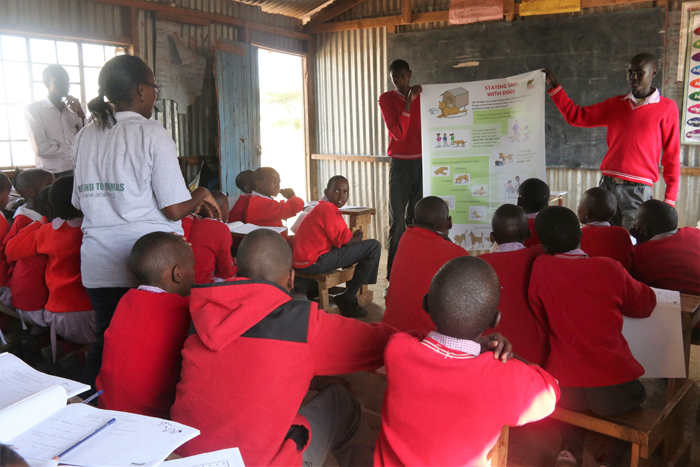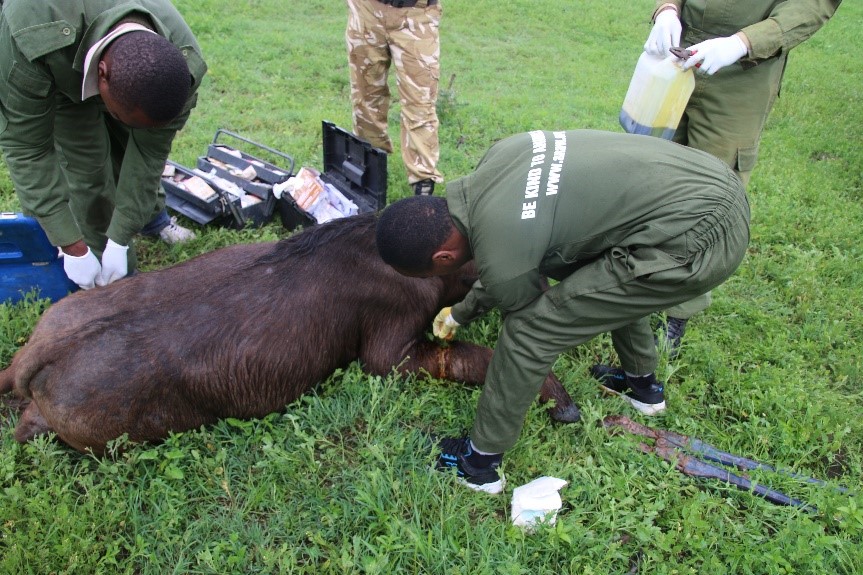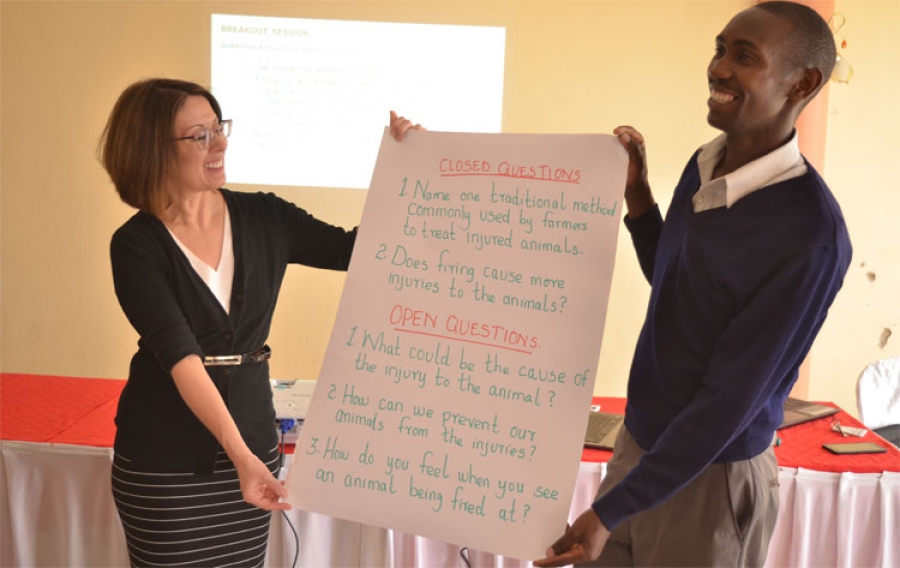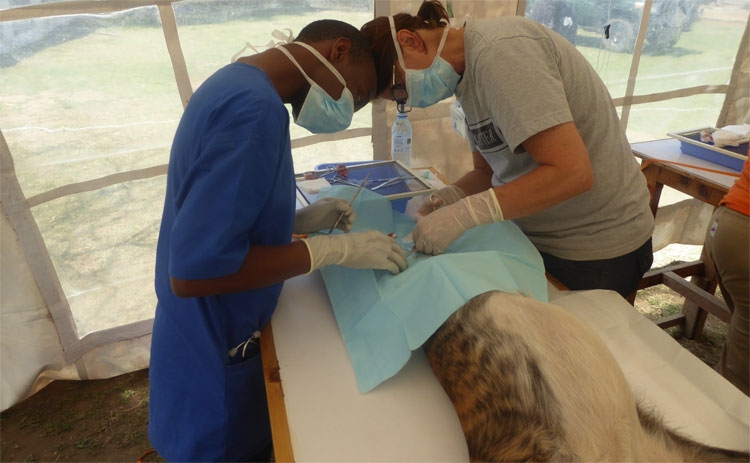 To work towards humane treatment of all animals in communities, attitude change is deemed as a critical pillar for the success of ANAW’s mission. Supported by findings from research information collected over time, ANAW has endeavored to promote a value based education program that inculcates young minds into compassionate individuals on the welfare of animals. This approach led to the establishment of the program called ‘Promoting Animal Welfare in Schools-PAWS’ run through the Animal Welfare Clubs in Kenya.
To work towards humane treatment of all animals in communities, attitude change is deemed as a critical pillar for the success of ANAW’s mission. Supported by findings from research information collected over time, ANAW has endeavored to promote a value based education program that inculcates young minds into compassionate individuals on the welfare of animals. This approach led to the establishment of the program called ‘Promoting Animal Welfare in Schools-PAWS’ run through the Animal Welfare Clubs in Kenya.
The animal welfare clubs were introduced in Kenya in 2013 through a partnership between the Society for the Protection of Animals Abroad (SPANA) - UK and Africa Network for Animal Welfare (ANAW). The program has since expanded to 42 schools spanning over 5 counties i.e. Machakos, Makueni, Kajiado, Nairobi and Kiambu Counties. So far a total of 5850 children have been impacted with knowledge on animals and animal welfare. This is expected to translate to attitude change in approximately 5850 households within the different counties, ultimately resulting to humane treatment of animals in these communities.
The program entails recruiting primary schools into the animal welfare clubs targeting 50 children from Grades 4-7 (mostly children aged between ages 7-13). In these clubs, basic principles on animal welfare are taught to the pupils for a one-year period. It employs an informal teaching methodology through such activities as discussions, games and puzzles which encourage critical thinking, close observation, problem solving and empathy development. Such children are then able to make decisions on their own regarding negative perceptions and myths about animals from an informed perspective.
PAWS is backed by the fundamentals of humane education. Animal welfare is one of the components of Humane Education. Humane Education is a form of education that encourages the understanding for the need of empathy, compassion and respect towards people, animals and the environment and understanding the interrelationship among the three. It is impossible to separate the three hence the need for harmony.
Unintentional cruelty is often passed from one generation to another and this makes humane education vital in our society. A child growing up in a home where animals are ill-treated will likely treat animals ill in future because he or she does not know otherwise. Teaching animal welfare education in schools is one of the best interventions we can offer.
The one-year curriculum used in Animal Welfare Clubs intends to equip children with basic knowledge in animal welfare such as the five welfare needs commonly known as the Five Animal Freedoms.
 It is the purpose of ANAW to demonstrate a hands-on approach to upholding World Organization for Animal Health (OIE) standards on animal welfare. These are internationally accepted practices agreed upon by all member states to be the bare minimum for animal welfare in each country.
It is the purpose of ANAW to demonstrate a hands-on approach to upholding World Organization for Animal Health (OIE) standards on animal welfare. These are internationally accepted practices agreed upon by all member states to be the bare minimum for animal welfare in each country.
As such ANAW works with various governments, communities and stake holders to support the enforcement of these regulations and observation of these standards in our program areas. The animal welfare needs within Kenya are enormous. However, ANAW- in full recognition of the situation and its limitations thereof- supports this course by focusing largely on companion animals, working animals and production animals.
Notably, ANAW’s work is anchored on the appreciation that animals have intrinsic value and are sentient beings able to respond to physiological changes in the environment.
Currently, specific projects being ran to achieve better care for animals include Animal Welfare Clinics and Anti-Bushmeat operations and Campaigns. As a hands-on organization, ANAW addresses the humane treatment of all animals by conducting animal health clinics such as the rabies vaccination clinics and spay/neuter clinics.
This humane treatment initiative dates back to 2006 where ANAW has since been working with both local and international partners to promote better care of pets. Pets in low income communities have been neglected and harshly treated as a result of fear due to the sporadic dog bites and suspected rabies cases reported. ANAW has endeavoured to address this by conducting anti-rabies and spay/neuter clinics in these communities.
ANAW continues to innovate its strategy on a day-to-day basis based on the unfolding of the actual experiences on the ground. These learnings are expected to translate into recommendations that will further define future interventions into offering better care of all animals while continuing to incorporate research into its endeavors.
 Humane education has been defined as the teaching of compassion and respect related to animal welfare, environmental ethics, and social justice issues. Unlike traditional forms of education which tend to focus on the acquisition of knowledge and skills as an end in its own right, humane education is principally concerned with the development of the learner into a more thoughtful and caring member of society, engaging all domains of learning to promote personal and community connections.
Humane education has been defined as the teaching of compassion and respect related to animal welfare, environmental ethics, and social justice issues. Unlike traditional forms of education which tend to focus on the acquisition of knowledge and skills as an end in its own right, humane education is principally concerned with the development of the learner into a more thoughtful and caring member of society, engaging all domains of learning to promote personal and community connections.
Humane education is dependent upon the integration of four key components. The first of these is knowledge, although not necessarily the same sort of knowledge that is taught as part of traditional academic subjects. For example humane education with respect to animal welfare requires knowledge of such things as animal husbandry and animal sentience, which fall outside the scope of standard biology syllabuses.
The second component is the development of higher order cognitive functioning such as curiosity, creativity, and critical thinking. This cannot be achieved through traditional didactic teaching methods. It instead requires the application of modern active teaching methods that engage the learner at a deeper cognitive level. Application of higher order cognitive skills to pertinent knowledge facilitates the development of an internally consistent schema of positive values in the learner. The promotion of values such as reverence, respect, and responsibility thus forms the third component. The combination of knowledge, cognitive skills, and positive values encourages the learner to behave in a socially beneficial way. With respect to animal welfare education, for example, the learner is empowered to make better decisions in their future lives that ultimately will impact positively on the welfare of those living beings in their own community and beyond.
 Anti-rabies vaccination clinics provide regular vaccinations to pets and have thus contributed both to the health of the pets and to the public at large. In areas where ANAW has provided routine rabies vaccination of dogs, reported cases of rabies from both dogs and humans has reduced considerably, there almost being zero cases reported in certain regions. This is such as Nakuru, Nairobi, Kajiado and Taita-Taveta Counties where vaccination campaigns have been undertaken successfully.
Anti-rabies vaccination clinics provide regular vaccinations to pets and have thus contributed both to the health of the pets and to the public at large. In areas where ANAW has provided routine rabies vaccination of dogs, reported cases of rabies from both dogs and humans has reduced considerably, there almost being zero cases reported in certain regions. This is such as Nakuru, Nairobi, Kajiado and Taita-Taveta Counties where vaccination campaigns have been undertaken successfully.
Spay Neuter initiatives ensure a 100% birth control measure compared to other prevailing interventions. These spay neuter campaigns reduce dog and cat populations leading to decreased incidences of reported cases of bites in addition to other detrimental human-animal encounters. The spay neuter clinics have led to a decrease in number of stray dogs and cats in communities where campaigns have been undertaken. Such areas include Nairobi and Naivasha Counties owing to successful campaigns, among other factors.
The anti-rabies vaccinations and spay neuter clinics, coupled with community sensitization, work in synergy to decrease animal suffering, educate local populations on the benefits of rabies vaccination and pet sterilization; and to eventually eliminate all incidences of dog, cat and human rabies attacks within the areas where rabies is being addressed.
The National and County governments have been steadfast to partner with ANAW in its ongoing efforts of humane treatment of animals throughout the years in earmarked counties.